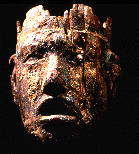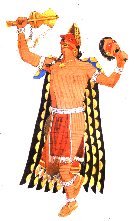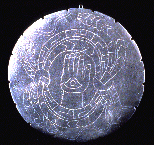Mississippian Society

Mississippian Society: Big Men and Priests, Chiefdoms, or State?
In contrast to earlier Native American societies of the American Bottom, Mississippian society was more hierarchical, its people differentiated by social, religious, and economic status as well as by occupation. The number and size of the mounds at Cahokia have impressed both casual observer and scholar for over 150 years. Clearly, the construction, elaboration, and maintenance of these mounds required the organization of labor for some period of time and must represent a level of social organization and social cooperation (or coersion) not previously seen in the valley. A Mississippian social, religious, political, and economic hierarchy is also indicated by some exotic trade goods such as whelk shells from the Gulf Coast and copper from the Upper Midwest, images of mythical beings on both utilitarian and ornamental objects, the differences house construction and the manner in which people were buried. Finally, the pattern of human settlement, sizes of habitation sites, and number of mounds at different sites suggest that this hierarchy extended to the region as a whole.

The different ways Mississippian people treated their dead indicate differences in their social and religious status as well as economic power during life. Burials found in small villages and hamlets, for example, lack the funerary objects and elaborate grave construction associated many burials from large villages and mound centers. A woman who died in a hamlet, for example, might be buried in a simple grave with a few pottery vessels and stone tools made of local materials. Constrast this typical hamlet and small town burial with some found in mounds at places like Cahokia. Status of some individuals from the mound centers and large towns is first revealed by the fact that some individuals were interred in mounds to mark their place of rest. Rich funerary objects, often finely crafted from exotic materials, lay next to individuals buried in mounds. The religious importance of some of these individuals (priest-chief? Gods?) may be reflected in the presence of ornamental jewelry with incised figures of mythical beings such as bird-men and winged serpents fashioned from rare stone and shell, or symbols like the weeping eye or cross in a circle.  Some measure of the social status and economic power of some individuals is indicated by the fact that many of these objects were imported to the American Bottom through trade - marine shells from the Gulf Coast - volcanic glass from the Rocky Mountains - mica from Appalachia - copper from the Upper Midwest.
Some measure of the social status and economic power of some individuals is indicated by the fact that many of these objects were imported to the American Bottom through trade - marine shells from the Gulf Coast - volcanic glass from the Rocky Mountains - mica from Appalachia - copper from the Upper Midwest.
A social hierarchy is also reflected in the construction of earthen mounds that obviously required the organization of labor. Similarly, the number, variety, and size of mounds at different places indicate that the ability of local chiefs to organize labor varied between towns. It has been suggested that the different categories of mound sites - villages with one mound, towns with more than one mound, and mound centers like Cahokia - represent hierarchical organization similar to our modern state. In this interpretation, important social, religious, and political decisions were made at Cahokia and handed down to secondary chiefs and priests in outlying towns and villages. Alternatively, some scholars have argued that while Cahokia was obviously important, the chiefs and priests of small towns and villages represent many small independent chiefdoms.
The demise of Cahokia is not well understood. Village life demanded wood for construction and fuel. Ever-increasing demands on this critical natural resource may have had a deleterious effect. Natural factors may have played a more catastrophic role. Like today, as the great floods of 1850, 1873, 1927, and 1993 illustrate, Mississippian life in the valley of one of the world's mightiest rivers was not without significant risks to homes, economy, and social life. Floods of this magnitude would have destroyed fields of beans, corn, and squash, flooded grain storage pits in villages, and disrupted the otherwise reliable harvesting of aquatic resources.
 Some measure of the social status and economic power of some individuals is indicated by the fact that many of these objects were imported to the American Bottom through trade - marine shells from the Gulf Coast - volcanic glass from the Rocky Mountains - mica from Appalachia - copper from the Upper Midwest.
Some measure of the social status and economic power of some individuals is indicated by the fact that many of these objects were imported to the American Bottom through trade - marine shells from the Gulf Coast - volcanic glass from the Rocky Mountains - mica from Appalachia - copper from the Upper Midwest.

